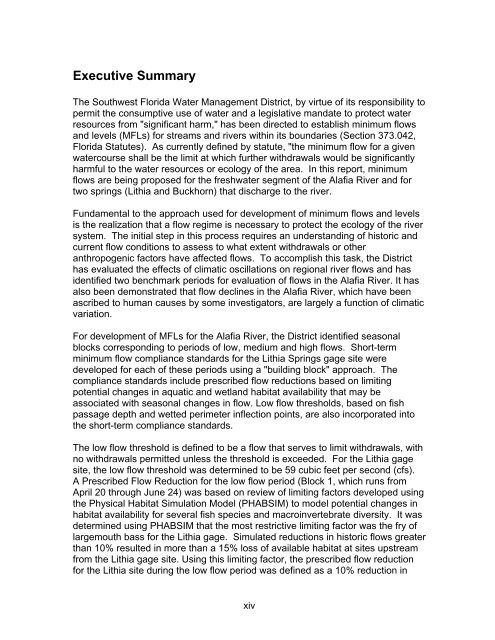Alafia River Minimum Flows and Levels - Southwest Florida Water ...
Alafia River Minimum Flows and Levels - Southwest Florida Water ...
Alafia River Minimum Flows and Levels - Southwest Florida Water ...
You also want an ePaper? Increase the reach of your titles
YUMPU automatically turns print PDFs into web optimized ePapers that Google loves.
Executive Summary<br />
The <strong>Southwest</strong> <strong>Florida</strong> <strong>Water</strong> Management District, by virtue of its responsibility to<br />
permit the consumptive use of water <strong>and</strong> a legislative m<strong>and</strong>ate to protect water<br />
resources from "significant harm," has been directed to establish minimum flows<br />
<strong>and</strong> levels (MFLs) for streams <strong>and</strong> rivers within its boundaries (Section 373.042,<br />
<strong>Florida</strong> Statutes). As currently defined by statute, "the minimum flow for a given<br />
watercourse shall be the limit at which further withdrawals would be significantly<br />
harmful to the water resources or ecology of the area. In this report, minimum<br />
flows are being proposed for the freshwater segment of the <strong>Alafia</strong> <strong>River</strong> <strong>and</strong> for<br />
two springs (Lithia <strong>and</strong> Buckhorn) that discharge to the river.<br />
Fundamental to the approach used for development of minimum flows <strong>and</strong> levels<br />
is the realization that a flow regime is necessary to protect the ecology of the river<br />
system. The initial step in this process requires an underst<strong>and</strong>ing of historic <strong>and</strong><br />
current flow conditions to assess to what extent withdrawals or other<br />
anthropogenic factors have affected flows. To accomplish this task, the District<br />
has evaluated the effects of climatic oscillations on regional river flows <strong>and</strong> has<br />
identified two benchmark periods for evaluation of flows in the <strong>Alafia</strong> <strong>River</strong>. It has<br />
also been demonstrated that flow declines in the <strong>Alafia</strong> <strong>River</strong>, which have been<br />
ascribed to human causes by some investigators, are largely a function of climatic<br />
variation.<br />
For development of MFLs for the <strong>Alafia</strong> <strong>River</strong>, the District identified seasonal<br />
blocks corresponding to periods of low, medium <strong>and</strong> high flows. Short-term<br />
minimum flow compliance st<strong>and</strong>ards for the Lithia Springs gage site were<br />
developed for each of these periods using a "building block" approach. The<br />
compliance st<strong>and</strong>ards include prescribed flow reductions based on limiting<br />
potential changes in aquatic <strong>and</strong> wetl<strong>and</strong> habitat availability that may be<br />
associated with seasonal changes in flow. Low flow thresholds, based on fish<br />
passage depth <strong>and</strong> wetted perimeter inflection points, are also incorporated into<br />
the short-term compliance st<strong>and</strong>ards.<br />
The low flow threshold is defined to be a flow that serves to limit withdrawals, with<br />
no withdrawals permitted unless the threshold is exceeded. For the Lithia gage<br />
site, the low flow threshold was determined to be 59 cubic feet per second (cfs).<br />
A Prescribed Flow Reduction for the low flow period (Block 1, which runs from<br />
April 20 through June 24) was based on review of limiting factors developed using<br />
the Physical Habitat Simulation Model (PHABSIM) to model potential changes in<br />
habitat availability for several fish species <strong>and</strong> macroinvertebrate diversity. It was<br />
determined using PHABSIM that the most restrictive limiting factor was the fry of<br />
largemouth bass for the Lithia gage. Simulated reductions in historic flows greater<br />
than 10% resulted in more than a 15% loss of available habitat at sites upstream<br />
from the Lithia gage site. Using this limiting factor, the prescribed flow reduction<br />
for the Lithia site during the low flow period was defined as a 10% reduction in<br />
xiv
















